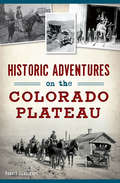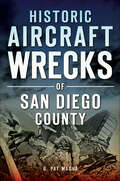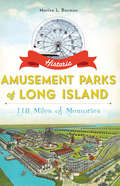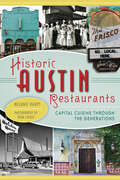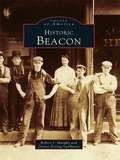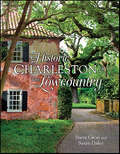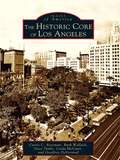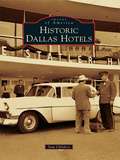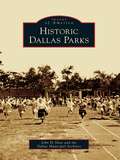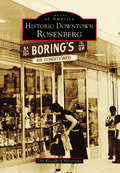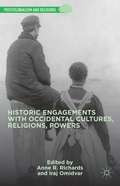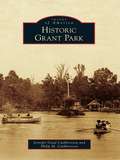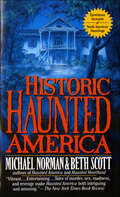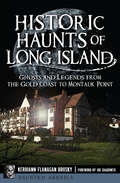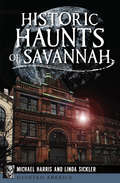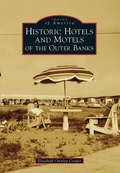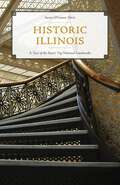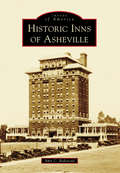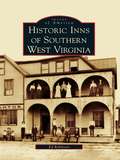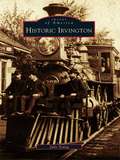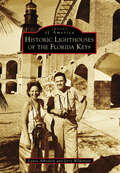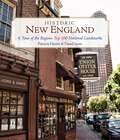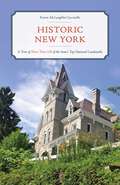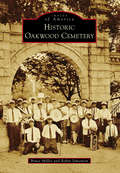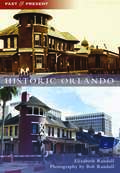- Table View
- List View
Historic Adventures on the Colorado Plateau (Transportation)
by Bob SilbernagelThe Colorado Plateau is home to nearly thirty national parks, monuments and recreational areas. The unique geology, stunning rock formations, powerful rivers and numerous scenic canyons that compose such a striking region also made navigation difficult. Yet daring explorers braved the journey. Rock art and other artifacts are evidence of occupation thousands of years ago. Spanish explorers once trekked across this rugged terrain, seeking information on the native populace, religious converts and trade routes. In the frontier era, a trio of bandits discovered the value of good horses while fleeing for three hundred miles. Nearly a century after the gold rush, uranium fever brought another boom to the rugged reaches of the area in the 1940s. Supported by years of research, Bob Silbernagel traces the Colorado Plateau's intrepid inhabitants throughout history.
Historic Aircraft Wrecks of San Diego County (Disaster)
by G. Pat MachaClear weather and a natural harbor made San Diego an early aviation hub, but success in flight came with devastating tragedies. The remains of more than four hundred aircrafts lie scattered across the county's deserts and mountains. Experts estimate that dozens more are on the ocean floor off the coast. In 1922, army pilot Charles F. Webber's DeHavilland biplane went missing over Cuyamaca Rancho State Park. In 1978, Pacific Southwest Airlines Flight 178 collided midair over San Diego and crashed in the residential North Park neighborhood, claiming the lives of 144 people in what was the worst airline disaster of the era. Author and aircraft accident research specialist G. Pat Macha recounts these and other stories of astonishing survival, heroism and heartbreaking fatality.
Historic Amusement Parks of Long Island: 118 Miles of Memories
by Marisa L. BermanWhen Long Island became a suburban paradise after World War II, ambitious entrepreneurs created dozens of amusement parks to help families unwind. The Nunley family built a park in Baldwin in 1939, and it was so successful that they opened Nunley's Happyland in Bethpage just a few years later. Westbury's Spaceland fascinated youngsters with dreams of becoming astronauts, and Frontier City in Amityville was heaven on earth to fans of the Wild West. Today, historic parks like Deno's Wonder Wheel Park in Coney Island and Adventureland in Farmingdale still delight children and remind parents of happy memories of their own. Local author Marisa Berman explores the decades of fun and laughter from Long Island's historic amusement parks.
Historic Austin Restaurants: Capital Cuisine through the Generations (American Palate)
by Melanie HauptAustin has staked its claim as the seat of innovative culinary movements, and its food culture mirrors the transformations taking place across the city. The evolution of the east side is reflected in joints like Franklin Barbecue, while landmarks like Scholz Garten, the oldest restaurant in the capital, testify to the contributions of the town's college presence and a healthy German influence. Joe's Bakery isn't just one of the town's most beloved Tex-Mex spots; it's the place where the real wheeling and dealing in Texas politics happens. Food writer Melanie Haupt samples Austin's iconic restaurants and the rich heritage that produced them.
Historic Beacon (Images of America)
by Denise Doring Vanburen Robert J. MurphyResidents of Beacon, New York, are justifiably proud of a community that is rich in history and promise. In this exquisite collection of images, local historians Robert J. Murphy and Denise Doring VanBuren uncover the fascinating past of Beacon andthe people who have called it home. The community's earliest permanent European settler was Madam Catheryna Rombout Brett, whose c. 1709 home is preserved within the city as the the oldest building in Dutchess County. Within the vicinity of the Madam Brett Homestead, two distinct villages grew: Matteawan, a manufacturing community at the foot of the mountain, and Fishkill Landing, a Hudson River port. Both villages prospered and eventually merged in 1913. Through the decades, the community was hailed as a model of a successful manufacturing center and became the location for several significant Hudson River estates. It played host to one of the longestrunning ferries in American history and introduced one of the first electric streetcar systems in the Hudson River Valley. Perhaps its most well-known feature was the Mount Beacon Incline Railway, a feat of engineering documented as the world's steepest incline railroad.
Historic Charleston & the Lowcountry
by Steve Gross Susan DaleyIn this elegant hardbound volume, photographers Steve Gross and Susan Daley take you on an intimate tour of some of the finest historic homes, gardens, churches, and plantations of the old city of Charleston and its surrounding Lowcountry. Their luminescent photographs reveal an insider's look at the definitive architecture and landscape of the region, ranging from private gardens hidden behind wrought iron gates to some of America's first landscaped garden vistas. From colonial-era French Quarter homes to Federal and Greek Revival townhouses and antebellum plantation houses, the selection featuring old family, private homes to museum showplaces make this an essential book for visitors, architects, preservationists or armchair travelers.
Historic Core of Los Angeles, The
by Linda Mccann Curtis C. Roseman Dace Taube Ruth WallachIn the early 20th century, there was no better example of a classic American downtown than Los Angeles. Since World War II, Los Angeles's Historic Core has been "passively preserved," with most of its historic buildings left intact. Recent renovations of the area for residential use and the construction of Disney Hall and the Staples Center are shining a new spotlight on its many pre-1930s Beaux Arts, Art Deco, and Spanish Baroque buildings.
Historic Dallas Hotels (Images of America)
by Sam ChildersIn Dallas's infancy, accommodations for the traveler arriving by stage or horseback consisted of boardinghouses or unfurnished rooms, but within 10 years of the city's founding, Dallas could boast about what is considered to be its first hotel: Thomas Crutchfield's log cabin and livery stable. As the village evolved from town to city, these early facilities were replaced with elegantly appointed hotels that rivaled those in New York or Chicago and established Dallas as a modern city. As the 20th century progressed, many older hotels were replaced with up-to-date facilities, and the rise of the automobile following World War II saw the establishment of dozens of motels and motor courts. There were accommodations for every type of traveler, and Dallas had established itself as a hotel town.
Historic Dallas Parks
by Dallas Municipal Archives John H. SlateDallas, called "Big D," is the eighth largest city in the United States and rests on 343 square miles of rolling prairie. To meet the growing recreational and cultural needs of its citizens, the Dallas Park and Recreation Department maintains more than 23,018 park acres--one of the largest municipal park systems in the country. Dallas has over 400 individual parks, including community centers, swimming pools, athletic fields, and a metropolitan zoo. From such well-known places as Fair Park, home of the State Fair of Texas and the Texas Centennial Exposition of 1936, to Dealey Plaza, and to lesser-known neighborhood parks, Dallas parks have a rich history stretching from the days when Dallas was a western boom town to a 21st century metropolis. Historic Dallas Parks explores the origins and early development of this nationally recognized system with interesting background stories and facts and illustrated with photographs and historical documents from the collections of the Dallas Municipal Archives.
Historic Downtown Rosenberg
by The Rosenberg HistoriansRosenberg was created and thrived with the expansion of the railroad. From the first house in 1883, the city grew to become the "Hub of the Gulf Coast." Rosenberg was the center of commerce for settlers of all nationalities attracted here by fertile land and economic opportunity. In just 30 years, 56 businesses, including banks, loan and land development companies, merchants, doctors, and lawyers, were in the four-block area of the original Downtown Rosenberg Business District. Even celebrities came. For instance, outlaws Bonnie and Clyde ate their last meal at the Eagle Café in 1934. Also, actors John Wayne, Shirley Temple, and Roy Rogers could occasionally be found outside the Cole Theater, and while campaigning, Lyndon B. Johnson had his helicopter land on a downtown roof.
Historic Engagements with Occidental Cultures, Religions, Powers
by Anne R. Richards Iraj OmidvarThis book explores centuries of power relations and imperial and civilizing rhetorics, overarching themes highlighted in these infrequently heard accounts by eastern travelers to the West. Considered in depth are evolutions in mental frameworks and practices that led to the emergence of anticolonial consciousness and strategies of protest.
Historic Grant Park (Images of America)
by Philip M. Cuthbertson Jennifer Goad CuthbertsonBoth the neighborhood of Grant Park and the 131-acre park take their shared name from railroad executive Lemuel P. Grant. The park was a gift to the City of Atlanta from Grant and was designed by John Charles Olmsted, the stepson of Frederick Law Olmsted. It became an urban haven where people came to "take the waters" from its natural springs, canoe on Lake Abana, and stroll the winding pathways in the pastoral park. A neighborhood sprang up around this oasis and was filled with homes that were designed in the spirit of Victorian painted ladies, Craftsman bungalows, Queen Anne, and New South cottages. In 1979, the structures within the neighborhood and park were placed on the National Register of Historic Places.
Historic Haunted America
by Michael Norman Beth ScottContinuing the success of the nationally acclaimed Haunted America, Historic Haunted America is a further investigation into North American ghost legends. This chilling collection documents yesterday's and today's most terrifying hauntings in the United States and Canada in more than seventy-five shocking stories!At the Publisher's request, this title is being sold without Digital Rights Management Software (DRM) applied.
Historic Haunts of Long Island: Ghosts and Legends from the Gold Coast to Montauk Point (Haunted America)
by Kerriann Flanagan BroskyTake a ghostly journey through Long Island&’s history—photos included! Ghosts lurk at the Execution Rocks Lighthouse, where Revolutionary War Patriots were brutally tortured and killed by the British during the Battle of Long Island. Popular gathering places have otherworldly tenants, including Bayport&’s Grey Horse Tavern and the Cutchogue Village Green, where several old buildings—and their former inhabitants—are preserved. Long Island&’s history, dating all the way back to its Native American legends, is unearthed and preserved through its ghost stories and the spirits that have made their presence known. Through extensive research, interviews, and investigations, award-winning author and historian Kerriann Flanagan Brosky, alongside medium and paranormal investigator Joe Giaquinto, uncovers Long Island's eerie history.
Historic Haunts of Savannah (Haunted America)
by Michael Harris Linda SicklerGeorgia&’s oldest city plays hostess to a bevy of ghostly guests whose stories are wrapped up in its rich southern history. As one of America&’s most haunted cities, Savannah, Georgia, has a long list of stories of the supernatural, such as the story of the first two people hanged in colonial Savannah for the murder of their abusive master. Or James Stark, a tempestuous planter, and Dr. Philip Minis, who settled their dispute with a duel and still hang around the old building at Moon River Brewing Co. Or the terrifying &“boy-giant,&” Rene Rhondolia, who preys on young girls and animals. Join authors Michael Harris and Linda Sickler as they navigate the chilling world of those who refuse to leave their Savannah homes. Includes photos! &“Story-loving Sickler and research-savvy Harris dug behind the ghost stories of what&’s called one of America&’s most haunted cities.&” —Savannah Now
Historic Hotels and Motels of the Outer Banks (Images of America)
by Elizabeth Ownley CooperIn the mid-1800s, wealthy farmers and businessmen began bringing their families to North Carolina's Outer Banks to escape the blistering inland summer heat. Soon after, the region's first hotel was built with accommodations for 200 guests. By the mid-1900s, hotels such as the Carolinian, the Nags Header, and the Arlington as well as smaller motels and cottage courts like Journey's End, the Sea Foam, and the Cavalier dotted the coastline. Most motels were independent, family-run operations. Many guests returned yearly, reuniting with the motel owners and other visitors. However, by the end of the 20th century, many of these mom-and-pop establishments had become a distant memory, lost to wrecking balls and replaced by large beach houses. This book recalls these hotels and motels and their impact on the Outer Banks and its visitors.
Historic Illinois: A Tour of the State's Top National Landmarks
by Susan O'Connor DavisHistoric Illinois: A Tour of the State&’s Top National Landmarks is a carefully curated travel guide, written by a local historian, featuring the most intriguing and significant of the state's nationally recognized historic landmarks. This guide provides interesting anecdotes and color photography of the famous homes, churches, and storefronts that represent the state's many architectural movements--from ancient mounds to Prairie School style. Tour the Land of Lincoln and travel back in time with Historic Illinois.
Historic Inns of Asheville
by Amy C. RidenourFor two centuries, people have traveled through the mountains of North Carolina to the city of Asheville. Early visitors came on foot, driving animals to market down the Buncombe Turnpike. Later, stagecoaches brought wealthy planters out of the heat of low-country summers. The railway brought an influx of visitors from all over the country, including Northerners escaping cold winters and patients looking for health cures. The advent of the automobile made travel even more accessible, and people flocked to the mountain town for scenery and entertainment. Tourism became central to Asheville's growth and industry, with many of the towns' prominent citizens taking part in the hotel trade and building iconic hotels like Battery Park and Grove Park Inn that attracted famous guests from all over the world. From simple hotels to large grand inns, economical boardinghouses, and accessible motels, Historic Inns of Asheville showcases the city's abundant history of accommodation.
Historic Inns of Southern West Virginia
by Ed RobinsonSouthern West Virginia possesses great natural beauty and a rich history in which lodging has played a significant role. This book traces the evolution of lodging in the area from the late 1700s to the present. The various types of accommodations included log cabins; lodging in rail, coal, and lumber communities; picturesque stagecoach stops; state parks; bed-and-breakfasts; and opulent mineral springs hotels. During the Civil War, many of the springs hotels and stagecoach stops were used for army hospitals and headquarters. This volume provides glimpses of quaint towns such as Bramwell, Fayetteville, Union, and Lewisburg, as well as the more commercial towns of Princeton, Bluefield, Hinton, Beckley, Glen Jean, Gary, Cass, Ronceverte, Marlinton, Coalwood, Rainelle, and Glen Rogers.
Historic Irvington (Images of America)
by Julie YoungFounded in 1870, historic Irvington serves as a time capsule to the bygone days of the Victorian and Edwardian eras. The once autonomous community along the Pennsylvania Railroad and U.S. Route 40 has a history as rich and spellbinding as the legendary tales of its namesake, Washington Irving. Featuring plenty of architectural diversity and notable citizens, Irvington served as the original home to Butler University and became known as a cultural, arts, and academic pillar of the Indianapolis landscape. Today Irvington continues to be the gem of Indianapolis's east side with locally owned shops and businesses along with a community that is committed to the past while focusing on the future.
Historic Lighthouses of the Florida Keys (Images of America)
by Jerry Wilkinson Laura AlbrittonThe Florida Keys possess a staggering wealth of lighthouses--nine in all, from the remote iron light at Fowey Rocks to classic brick structures at Key West and Loggerhead Key. In the 1820s, the US government began constructing lighthouses to aid mariners navigating the dangerous Florida Reef. While some of the original lights were subsequently destroyed in dramatic circumstances, most that followed, including Carysfort Reef, Alligator Reef, Sombrero Key, Sand Key, and American Shoal, survived intense tropical weather and even major hurricanes. Among the lighthouse keepers were remarkable women who succeeded in a profession usually reserved for men.
Historic New England: A Tour of the Region's Top 100 National Landmarks
by David Lyon Patricia HarrisNational Historic Landmarks are touchstones of our collective past that still resonate with our present. The six New England states have nearly 400 such places. However, important doesn't always translate into interesting and so we have Historic New England: A Tour of the Region&’s Top 100 National Historic Landmarks––those with the most intriguing and rewarding history. In addition to historic houses, tall ships, and such quirky spots as one of the country's oldest weather stations, carousels, and sandy beaches. The book appeals to the historical enthusiast, the armchair traveler, and both local visitors and tourists alike.
Historic New York: A Tour of More Than 120 of the State's Top National Landmarks
by Karen McLaughlin CuccinelloLandmarks are the Touchstones of the Meandering TravelerFrom homes that witnessed the birth of the American Revolution to quirky museum collections and vistas of natural splendor amid the Adirondack Mountains, New York is home to more than 270 National Historic Landmarks. Tour the Empire State and travel back in time to discover the unique stories of its history. Carefully curated by a local historian, Historic New York: A Tour of More Than 120 of the State&’s Top National Landmarks is the essential guide to the most memorable historic sites in the state. Whether you are a history enthusiast, a local visitor, or a tourist, there is something for everyone in this guide to New York&’s past.
Historic Oakwood Cemetery (Images of America)
by Bruce Miller Robin SimontonOakwood Cemetery evolved from a final resting place for Confederate soldiers to a modern “cemetery full of life,” reflecting over 150 years of the remarkable history of Raleigh, North Carolina. Many of the men and women who lived that history and developed this Southern capital—from soldiers and politicians to educators and clergy, from merchants and craftsmen to social activists and laborers—now rest in Oakwood, memorialized in the monuments that grace this lovely garden cemetery. Their stories, illustrated by archival and modern photographs, are told within this volume.
Historic Orlando (Past and Present)
by Elizabeth RandallOrlando's historic districts are separate throughout the city, yet its landmarks and its memories unite them. Images of Orlando from 1875 to 2022 paint a picture of a landscape dotted with cattle and orange trees exploding into a bustling city. While some authors claim that Orlando's history is lost, these images show how the city's Historic Preservation Board has safeguarded many cultural and architectural treasures.
